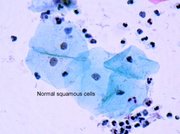Fibrous dysplasia is a benign idiopathic skeletal disorder that occurs when normal cancellous bone is replaced by abnormal fibrous tissue. The fibrous tissue replaces the spongiosa and fills in the medullary cavity with poorly calcified trabeculae. (1-3)
Fibrous dysplasia represents 2.5% of all bone tumors and 7.5% of all benign bone tumors. (3,4) These tumors usually arise during early childhood or adolescence, and they tend to stabilize after puberty. They occur equally in males and females. Recurrence during adulthood has been noted in approximately 37% of cases. (3,4)
Fibrous dysplasia has two basic clinical forms: monostotic and polyostotic. (1)
The monostotic form, which accounts for approximately 70% of all cases, involves one or two contiguous bones, usually the ribs and the femora. (3) Craniofacial involvement occurs in 10 to 25% of cases; the maxilla and mandibula are most commonly affected. (4)
In the polyostotic form, which accounts for approximately 30% of cases, various areas of the skeleton can be involved; craniofacial involvement occurs in 40 to 50% of cases. (4) Polyostotic fibrous dysplasia, along with endocrine abnormalities and cutaneous hyperpigmentation, is a component of Albright-McCune-Sternberg syndrome, a rare condition that primarily affects females.
Patients with the monostotic form are frequently asymptomatic. They are often diagnosed incidentally during radiographic evaluation for another purpose. Conversely, patients with the polyostotic form have early manifestations, including bone pain and/or bone deformity. These conditions can lead to symptoms of vascular and neurologic compromise, which are easily diagnosed at an early stage.
Craniofacial disease can manifest as headaches and facial distortion (leontiasis ossea). Less severe cases can be characterized by an asymmetric prominence of the face, nasal or sinus obstruction, exophthalmos, and epiphora. Visual and neurologic deficits may occur as a result of cranial nerve involvement. (2,4) Sinus obstruction secondary to fibrous dysplasia may result in infection and the formation of mucoceles.
On computed tomography (CT), the ground-glass appearance of fibrous dysplasia distinguishes it from other lytic lesions (figure 1). (2) Magnetic resonance imaging (MRI) helps evaluate the soft-tissue component, and it can distinguish fibrous dysplasia from other tumors, such as meningiomas (figure 2). Mucocele formation with intracranial or orbital extension is not an uncommon complication of sinus obstruction; this occurs more often in the sphenoid and frontal sinuses and is best assessed by MRI. (2,3)
[FIGURE 1-2 OMITTED]
References
(1.) Bibby K, McFadzean R. Fibrous dysplasia of the orbit. Br J Ophthalmol 1994;78:266-70.
(2.) Daffner RH. Kirks DR, Gehweiler JA, Jr., Heaston DK. Computed tomography of fibrous dysplasia. AM J Roentgenol 1982; 139(5):943-8.
(3.) Jan M, Dweik A, Destrieux C, Djebbari Y. Fronto-orbital sphenoidal fibrous dysplasia. Neurosurgery 1994;34:544-7.
(4.) Som PM, Brandwein M. Tumors and tumor-like conditions. In: Som PM, Curtin HD, eds. Head and Neck Imaging. 4th. ed. St. Louis: Mosby, 2003:331-40.
COPYRIGHT 2004 Medquest Communications, LLC
COPYRIGHT 2004 Gale Group



